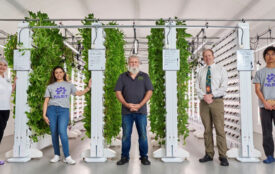MCC-led research team quantifies the “gap” in carbon removal for the first time
Taking its cue from the UN Emissions Gap Report. Countries’ current plans to extract CO2 from the atmosphere are off-track to comply with the 1.5-degree limit.
Since 2010, the United Nations environmental organisation UNEP has taken an annual measurement of the emissions gap: the difference between countries’ climate protection pledges and what would be necessary to limit global heating to 1.5 (or at least below 2) degrees. The UNEP Emissions Gap Reports are clear: climate policy needs more ambition. A new study now explicitly applies this analytical concept to carbon dioxide removal – the extraction of the most important greenhouse gas, CO2, from the atmosphere. The study was led by the Berlin-based climate research institute MCC (Mercator Research Institute on Global Commons and Climate Change), and published in the renowned journal Nature Climate Change.
“In the Emissions Gap Reports, carbon removals are only accounted for indirectly” explains William Lamb, a researcher in the MCC working group Applied Sustainability Science, a UNEP lead author since 2022 and also lead author of the new study. “After all, the usual benchmark for climate protection pledges is net emissions, i.e. emissions minus removals. We are now making transparent the specific ambition gap in scaling up removals. This planetary waste management will soon place completely new requirements on policymakers, and may become a central pillar of climate protection in the second half of the century.”
According to the study, if national targets are fully implemented, annual human-induced carbon removals could increase by a maximum of 0.5 gigatonnes of CO2 (i.e. 500 million tonnes) by 2030, and by a maximum of 1.9 gigatonnes by 2050. This contrasts with the 5.1 gigatonne increase by 2050 required in a “focus scenario”, which the research team depicts as typical from the latest Intergovernmental Panel on Climate Change (IPCC) assessment report. There, global heating, calculated over the entire course of this century, is limited to 1.5 degrees, and a particularly rapid expansion of renewable energies and reduction of fossil emissions is depicted as the core climate protection strategy. But, even so, the focus scenario still relies on scaling up carbon removals. The gap for the year 2050 is therefore at least 3.2 gigatonnes of CO2 (5.1 minus a maximum of 1.9).
An alternative focus scenario, also derived from the IPCC, assumes a significant reduction in global energy demand, due to politically initiated behaviour changes as the core element of climate protection strategy. Here, carbon removals would increase by a more modest amount: 2.5 gigatonnes in 2050. Fully implemented national targets would be close to sufficient when compared to this scenario, with a gap in 2050 of 0.4 gigatonnes.
The research team points out the problem of sustainability limits in scaling up carbon removals. For example, the associated land area demand will come to jeopardise biodiversity and food security. Nevertheless, there is still plenty of room for designing fair and sustainable land management policies. In addition, novel carbon removal options, such as air filter systems, or “enhanced rock weathering”, have hardly been promoted by politicians to date. These options currently only remove 0.002 gigatonnes of CO2 per year from the atmosphere, compared to 3 gigatonnes through conventional options such as afforestation, and they are unlikely to significantly increase by 2030. According to the scenarios, they must become more prevalent than conventional options by 2100.
Since only 40 countries have so far quantified their removal plans in their “long-term low emissions development strategies”, the study also draws on other national documents and best-guess assumptions. “The calculation should certainly be refined,” says MCC researcher Lamb. “But our proposal using the focus scenarios further opens the discourse on how much carbon removal is necessary to meet the Paris Agreement. This much is clear: without a rapid reduction in emissions towards zero, across all sectors, the 1.5-degree limit will not be met under any circumstances.”
- The study: Lamb, W., Gasser, T., Roman-Cuesta, R., Grassi, G., Gidden, M., Powis, C., Geden, O., Nemet, G., Pramata, Y., Riahi, K., Smith, S., Steinhauser, J., Vaughan, N., Smith, H., Minx, J., 2024, The carbon removal gap, Nature Climate Change
- Summarising “Policy Brief” by the same authors also in Nature Climate Change








